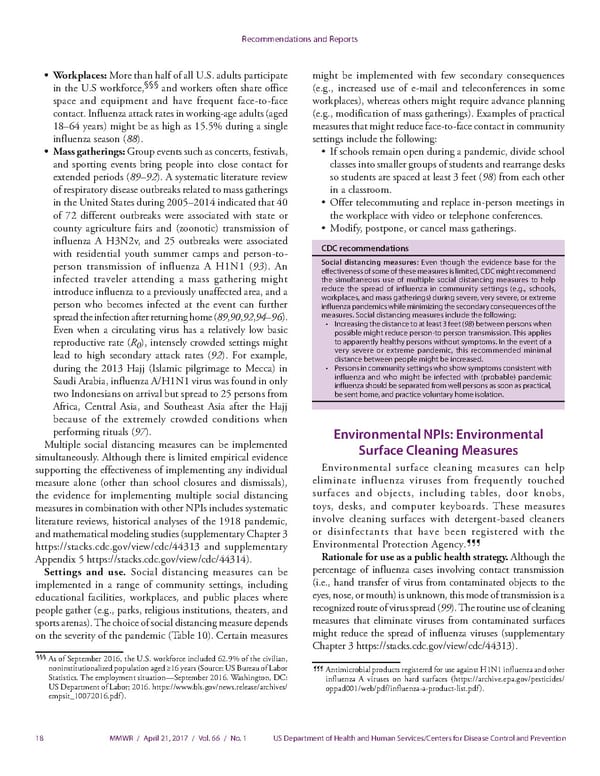Recommendations and Reports • Workplaces: More than half of all U.S. adults participate might be implemented with few secondary consequences §§§ in the U.S workforce, and workers often share office (e.g., increased use of e-mail and teleconferences in some space and equipment and have frequent face-to-face workplaces), whereas others might require advance planning contact. Influenza attack rates in working-age adults (aged (e.g., modification of mass gatherings). Examples of practical 18–64 years) might be as high as 15.5% during a single measures that might reduce face-to-face contact in community influenza season (88). settings include the following: • Mass gatherings: Group events such as concerts, festivals, • If schools remain open during a pandemic, divide school and sporting events bring people into close contact for classes into smaller groups of students and rearrange desks extended periods (89–92). A systematic literature review so students are spaced at least 3 feet (98) from each other of respiratory disease outbreaks related to mass gatherings in a classroom. in the United States during 2005–2014 indicated that 40 • Offer telecommuting and replace in-person meetings in of 72 different outbreaks were associated with state or the workplace with video or telephone conferences. county agriculture fairs and (zoonotic) transmission of • Modify, postpone, or cancel mass gatherings. influenza A H3N2v, and 25 outbreaks were associated with residential youth summer camps and person-to- CDC recommendations person transmission of influenza A H1N1 (93). An Social distancing measures: Even though the evidence base for the effectiveness of some of these measures is limited, CDC might recommend infected traveler attending a mass gathering might the simultaneous use of multiple social distancing measures to help introduce influenza to a previously unaffected area, and a reduce the spread of influenza in community settings (e.g., schools, workplaces, and mass gatherings) during severe, very severe, or extreme person who becomes infected at the event can further influenza pandemics while minimizing the secondary consequences of the spread the infection after returning home (89,90,92,94–96). measures. Social distancing measures include the following: Even when a circulating virus has a relatively low basic • Increasing the distance to at least 3 feet (98) between persons when possible might reduce person-to person transmission. This applies reproductive rate (R ), intensely crowded settings might to apparently healthy persons without symptoms. In the event of a 0 very severe or extreme pandemic, this recommended minimal lead to high secondary attack rates (92). For example, distance between people might be increased. during the 2013 Hajj (Islamic pilgrimage to Mecca) in • Persons in community settings who show symptoms consistent with Saudi Arabia, influenza A/H1N1 virus was found in only influenza and who might be infected with (probable) pandemic influenza should be separated from well persons as soon as practical, two Indonesians on arrival but spread to 25 persons from be sent home, and practice voluntary home isolation. Africa, Central Asia, and Southeast Asia after the Hajj because of the extremely crowded conditions when performing rituals (97). Environmental NPIs: Environmental Multiple social distancing measures can be implemented Surface Cleaning Measures simultaneously. Although there is limited empirical evidence supporting the effectiveness of implementing any individual Environmental surface cleaning measures can help measure alone (other than school closures and dismissals), eliminate influenza viruses from frequently touched the evidence for implementing multiple social distancing surfaces and objects, including tables, door knobs, measures in combination with other NPIs includes systematic toys, desks, and computer keyboards. These measures literature reviews, historical analyses of the 1918 pandemic, involve cleaning surfaces with detergent-based cleaners and mathematical modeling studies (supplementary Chapter 3 or disinfectants that have been registered with the https://stacks.cdc.gov/view/cdc/44313 and supplementary Environmental Protection Agency.¶¶¶ Appendix 5 https://stacks.cdc.gov/view/cdc/44314). Rationale for use as a public health strategy. Although the Settings and use. Social distancing measures can be percentage of influenza cases involving contact transmission implemented in a range of community settings, including (i.e., hand transfer of virus from contaminated objects to the educational facilities, workplaces, and public places where eyes, nose, or mouth) is unknown, this mode of transmission is a people gather (e.g., parks, religious institutions, theaters, and recognized route of virus spread (99). The routine use of cleaning sports arenas). The choice of social distancing measure depends measures that eliminate viruses from contaminated surfaces on the severity of the pandemic (Table 10). Certain measures might reduce the spread of influenza viruses (supplementary Chapter 3 https://stacks.cdc.gov/view/cdc/44313). §§§ As of September 2016, the U.S. workforce included 62.9% of the civilian, noninstitutionalized population aged ≥16 years (Source: US Bureau of Labor ¶¶¶ Antimicrobial products registered for use against H1N1 influenza and other Statistics. The employment situation—September 2016. Washington, DC: influenza A viruses on hard surfaces (https://archive.epa.gov/pesticides/ US Department of Labor; 2016. https://www.bls.gov/news.release/archives/ oppad001/web/pdf/influenza-a-product-list.pdf). empsit_10072016.pdf). 18 MMWR / April 21, 2017 / Vol. 66 / No. 1 US Department of Health and Human Services/Centers for Disease Control and Prevention
 Community Mitigation Guidelines to Prevent Pandemic Influenza Page 19 Page 21
Community Mitigation Guidelines to Prevent Pandemic Influenza Page 19 Page 21